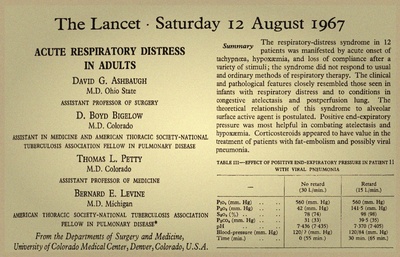📜 Journal Club – Classic Papers: 58 Years Since the First Description of Acute Respiratory Distress Syndrome (ARDS)
By: Marcelo Alcantara, Médico - 08/18/2025 11:27
👉🏼 In the second week of August 1967, the American authors:
David G. Ashbaugh
M.D., Ohio State University
Assistant Professor of Surgery
D. Boyd Bigelow
M.D., University of Colorado
Assistant in Medicine and American Thoracic Society–National Tuberculosis Association Fellow in Pulmonary Disease
Thomas L. Petty
M.D., University of Colorado
Assistant Professor of Medicine
Bernard E. Levine
M.D., University of Michigan
American Thoracic Society–National Tuberculosis Association Fellow in Pulmonary Disease
👉🏼 Published the first description of the Acute Respiratory Distress Syndrome (ARDS) in the traditional journal The Lancet, founded back in 1823 in the United Kingdom.
👉🏼 The work was carried out in the Departments of Surgery and Medicine at the University of Colorado Medical Center, Denver, Colorado, USA.
🤔 Interesting, so many years later, to see how much can be inferred simply through observation and careful recording of patient cases, with reflections based on pathophysiology and an integrated clinical and scientific “eyes” aiming to identify and classify patterns. This rare characteristic of human "natural intelligence" continues to be the foundation of Medical Science.
👉🏼 Describing clinical, functional, radiological, pathological features, the response to mechanical ventilation with positive pressure and to pharmacotherapy in only 12 patients, the authors highlighted the following central findings to define what was then the brand-new syndrome:
Acute onset of tachypnea
Hypoxemia
Decreased lung compliance
Bilateral pulmonary infiltrates on chest x-rays
👉🏼 Respiratory failure was triggered by different factors occurring between 1 hour and 4 days before onset, including:
Polytrauma (with or without pulmonary contusion) in 7 patients
Viral pneumonia in 4 patients
Pancreatitis in 1 patient
Five of these patients had severe hypotension.
👉🏼 The clinical and pathological features (evaluated in autopsies of the seven patients who died, 58%) resembled those of the already described Respiratory Distress Syndrome in newborns, including findings of:
Congestive atelectasis
Post-perfusion lung conditions
🤔 A possible relationship with surfactant inactivation was also postulated.
💡 Positive end-expiratory pressure (PEEP) was the most effective strategy to combat atelectasis and hypoxemia. Yes, PEEP came to life with ARDS!
🤔 Corticosteroids were shown to be helpful in the treatment of:
Fat embolism
Possibly in cases of viral pneumonia
Sensational, isn’t it?
Here’s the link to the original article:
😉 In upcoming posts on this same topic, we’ll discuss interesting points of this story that began in 1967 and still has no end date in sight. Many aspects still need to be better understood and connected for improved comprehension and treatment of patients with ARDS.
To add an answer on this topic and read the replies...
You must have a valid and active xlung subscription
If you are already a subscriber, please Login at the top of the page, or subscribe now
